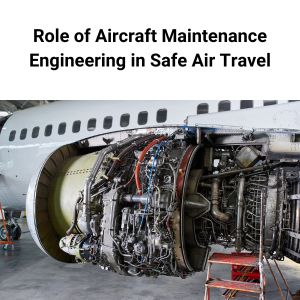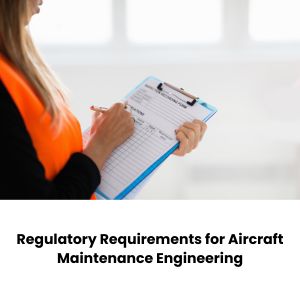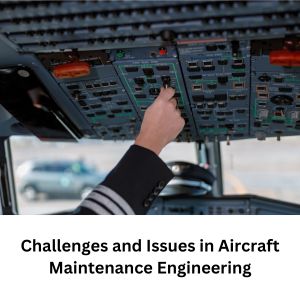

The importance of Aircraft Maintenance Engineering (AME) in maintaining aviation security cannot be overstated. The aircraft's maintenance, overhaul, and repair are the responsibility of AME professionals, who also ensure that the aircraft is in top functioning order before each flight.
The AME's contribution to secure air transport includes:
Regular Maintenance: To guarantee that all systems are in flawless operating order, AME personnel conduct routine maintenance inspections on aircraft. The engine, avionics, hydraulic and pneumatic systems, and other parts must be checked to ensure they operate correctly.
Inspection: AME specialists are in charge of checking each aircraft component to ensure it is safe to fly. Prior to every flight, they contain the aircraft, and they also conduct more thorough checks occasionally.
Troubleshooting: If a problem arises, AME personnel investigate it and make the necessary repairs to make sure the aircraft is fit for flight.
Regulation Compliance: AME personnel must abide by rules and directives established by aviation regulators like the Federal Aviation Administration (FAA) or the European Aviation Safety Agency (EASA). The safety of the aircraft for operation is ensured by adherence to these regulations.
In conclusion, aircraft maintenance engineering plays a critical role in ensuring safe air travel. Before each flight, AME personnel are in charge of examining and troubleshooting the aircraft, ensuring it is in perfect functioning order and according to rules. They contribute to making sure that passengers may travel without incident and in safety.
If you want to make your future in Aircraft Maintenance Engineering, you can be an admission to WIIA in India.
In order to ensure the safety of air travel, the field of aircraft maintenance engineering (AME) is heavily regulated. Regulatory requirements for AME differ by nation, but generally speaking, they consist of the following:
License: AME practitioners must possess a current licence granted by the appropriate regulatory organisation in their nation. For instance, the Federal Aviation Administration (FAA) in the US is responsible for issuing AME licences. AME licences are issued by the European Aviation Safety Agency (EASA) in Europe.
Training: AME practitioners must complete a rigorous training programme before receiving a licence. The training normally covers aircraft systems, maintenance practices, and regulations and includes both academic and practical components.
Certification: To operate on particular types of aircraft, AME specialists need to be certified. For instance, an AME qualified to work on Boeing 747s might not be qualified to work on Airbus A380s.

Regulation Compliance: AME professionals are required to abide by the rules established by the national regulatory agency. These rules address things like maintenance protocols, safety requirements, and recordkeeping.
Continuous Education: To stay current with the newest technology and laws, AME professionals must participate in ongoing education. Attending training sessions or conferences may be necessary for this.
Quality Control: To guarantee that all maintenance work is completed to the highest standards, AME personnel must operate within a Quality Control framework. This entails adhering to specified protocols, carrying out frequent inspections, and carrying out audits.
In conclusion, there are many regulatory criteria for AME experts in order to ensure that they are qualified, certified, and compliant with safety laws. By adhering to these regulations, air travel is made safer and more dependable.

An essential part of aviation is the maintenance and repair of aircraft in order to maintain their safety. This is known as aircraft maintenance engineering (AME). AME professionals may confront the following Challenges:
Complex and advanced technologies: Modern aviation systems are growing more sophisticated and complicated, necessitating AME specialists' training and extensive technical understanding to maintain and repair them.
Compliance with stringent restrictions: To guarantee the safety and airworthiness of the aircraft, AME specialists must abide by strict regulations set by the aviation authorities. The complexity and rapid changing of these regulations exacerbate the difficulties of staying current.
Cost pressures: AME specialists must adhere to the highest safety and quality requirements while staying within budgetary restrictions and minimising maintenance costs.
Weather factors: Because aircraft maintenance is frequently done outside, AME specialists are subjected to challenging weather factors such as severe temperatures, wind, and rain.
Ageing aircraft: Due to increased wear and tear, many aircraft now in use are ageing, which can present maintenance issues. AME experts must handle these problems while upholding airworthiness and safety.
In conclusion, AME professionals encounter a variety of issues that demand extensive knowledge, training, and attention to detail. They have to work in hostile environments, understand complicated technologies, adhere to rigorous rules, put safety first, manage costs and schedule restrictions, and repair ageing aeroplanes. It takes a dedication to safety, a focus on ongoing innovation and development, and the adoption of cutting-edge procedures and technology to overcome these obstacles.
For air travel to be safe and reliable, skilled and trained aircraft maintenance engineers (AME) are essential. They are crucial to maintaining the highest levels of safety and airworthiness and ensuring that aircraft are in excellent functioning order before each trip. The following examples illustrate the significance of knowledgeable AME:
Reliability: AME specialists preserve an aircraft's dependability through routine maintenance, repairs, and overhauls. This makes it possible to guarantee that aeroplanes run effectively and are available for use when needed, according to the timetable.
Regulation adherence: AME practitioners are required to adhere to stringent rules and guidelines established by aviation regulators like the Federal Aviation Administration (FAA) or the European Aviation Safety Agency (EASA). Professionals in the AME field who are skilled and trained are aware of the significance of compliance and the repercussions of non-compliance.
Compliance with regulations: AME professionals must abide by strict rules and regulations set forth by aviation regulators like the Federal Aviation Administration (FAA) or the European Aviation Safety Agency (EASA). The importance of compliance and the consequences of non-compliance are known to knowledgeable and trained professionals in the AME industry.
Efficiency: Trained and skilled AME employees can do maintenance tasks more rapidly, lowering maintenance costs and downtime.
Innovation: Skilled and knowledgeable AME experts are at the vanguard of innovation, embracing new technology and procedures to boost effectiveness, dependability, and safety.
Reputation: The reputation of the aviation sector is boosted by skilled and well-trained AME specialists. They ensure that aeroplanes run securely and dependably thanks to their knowledge and attention to detail, which boosts passenger confidence in flying.
In conclusion, the aviation sector's safety, dependability, and reputation depend heavily on the skills and training of AME specialists. They make sure that aeroplanes are in excellent operational order, adhere to rules, run effectively, and implement new technology and procedures. Their work has a direct impact on the satisfaction and safety of passengers and crew, so its significance cannot be understated.
To learn more about Aircraft Maintenance Engineering, you can enrol at WIIA.